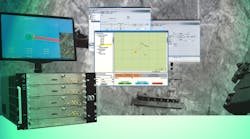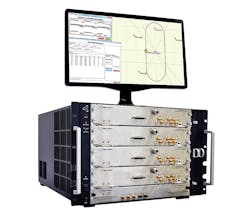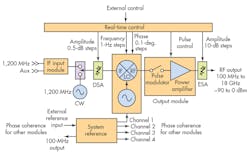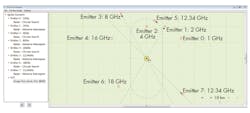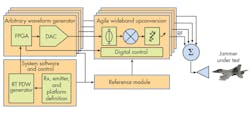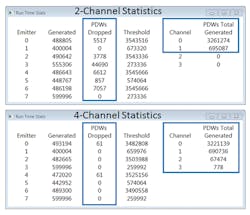Download this article as a .PDF
Electronic warfare (EW) systems must undergo stringent testing before they can be deployed: Few technologies in the defense electronics inventory face greater challenges or play a greater role in ensuring warfighter survivability than EW systems. They must not only detect an adversary’s radar, typically in a dense electromagnetic (EM) signal environment, but also determine how to defeat it and then attempt to provide a solution that cancels or minimizes the threat. Failure can be a matter of life or death.
Test regimes for readying an EW system for the field are exhaustive, ranging from simulation and emulation on the benchtop to higher and higher (and increasingly costly) levels of stress testing to ensure effective operation under a wide range of operating conditions, ultimately resulting in exposure to an enormous array of threats on an open-air test range.
This “final exam” last step is the potential deal breaker because there are few such test ranges and many programs to test, so there is typically a long waiting list. Fail this test and the next chance will be months (and perhaps a year) away. Nevertheless, these systems are required for final sign-off before the asset can be deployed.
Taking this “do-or-die” final test scenario into consideration, it’s obviously essential that testing against threat waveforms begins as early as possible in the design process, when it’s easiest to perform and EW system changes can be made quickly and inexpensively. The greater the realism in this testing, the better the chances of success are during the candidate EW system’s Initial Operational Capability (IOC) evaluation. Achieving this requires that emulated signal environments be highly representative of those the system will experience in service.
That is to say, an effective EW emulator must create the signal environment for all moments in time, all RF emitter positions and ranges, and for all emitters as they dynamically move through a battlespace with changing amplitudes, phases, and frequencies. Fortunately, modern field-programmable-gate-array (FPGA) architectures and real-time frequency synthesizers allow for such realism to be generated for bench-top and open-range applications.
The Giga-tronics Real-Time Threat Emulation System (TEmS) was created to make this achievable as a modular and scalable commercial-off-the-shelf (COTS) bench-top EW threat emulation solution (Fig. 1). It is designed to bridge the gap between large-format emulators and traditional COTS test equipment to provide cost-effective open-loop threat emulation. The company combined its 35 years of experience in developing high-performance frequency synthesizers with the capabilities of partners with long experience in creating closed-loop, high-fidelity signal environment emulations.
The TEmS system is compact enough to fit on a test bench. It is equally suited for use in early design verification, and is modular so it can be reconfigured for more complex testing during final system verification. This modular approach allows the hardware to scale at the module level rather than through the addition of expensive standalone instruments.
Its open-loop software lets designers improve their system design at any stage of development. In short, the ability to test all or part of a system at the board, module, and system level makes it possible for engineers to identify and fix design issues well before testing on the range.
TEmS is the only test system that performs phase-coherent upconversion and provides a deterministic real-time interface to control frequency, phase, and amplitude at the RF carrier. While these parameters could have been controlled at baseband frequencies, that approach is limited in dense signal emulation environments because the emulation system’s digital-to-analog converter (DAC) must share its available signal output power across all simulated threats and have sufficient sample bandwidth to create agile emitters.
These capabilities enable users to create high-performance scripted open-loop emulations and are the building blocks for real-time closed-loop emulation systems. In addition, unlike traditional COTS test tools, the TEmS open-loop software incorporates the comprehensive kinetic effects (the movement of all types of emitters in relation to each other in space) that are essential for creating a signal environment that realistically represents what the EW system will encounter in service.
The system’s agile wideband upconverters are used for signal synthesis and real-time control of RF parameters. Signal generation with high-resolution control is performed by the Giga-tronics Advanced Signal Generator (ASG). The ASG (Fig. 2) is part of the firm’s Real-Time Synthesizer (RTS) family of modules for multi-channel, phase-coherent, upconverters and downconverters.
The ASG is based on a 100-MHz reference, which also provides additional outputs for synchronization of other modules in the emulation system. The ASG is capable of high-resolution tuning of generated signals, with 0.5-dB amplitude resolution, 1-Hz frequency resolution, and 0.1-deg. phase resolution.
Real-time control of the ASG’s frequency, phase, and amplitude is accomplished through a parallel binary-coded-decimal (BCD) interface allowing frequency, phase, and amplitude to be changed in less than 1 microsecond over a frequency range of 100 MHz to 18 GHz. This supports synthesis of multiple emitters on a single RF channel that operate at different RF center frequencies. Each ASG module can translate an IF waveform signal centered at 1200 MHz to anywhere in the spectrum between 100 MHz and 18 GHz. The IF can have an intrapulse Instantaneous Bandwidth (IBW) up to 1 GHz for output frequencies above 4 GHz.
Multiple, phase-coherent channels are realized using the system reference module that distributes the required analog timing signals plus Local Oscillator (LO) signals across Zone 3 of the AXIe chassis. The reference module also provides a 100 MHz reference output for maintaining phase-coherent operation across multiple AXIe chassis. AXIe Zone 3 implements a coherent analog synchronization bus for sharing frequency reference signals and critical timing clocks from the reference module.
The approach eliminates a significant amount of front-panel cabling and uses AXIe’s active backplane for external PCIe and Ethernet interfaces. The chassis reports its status over PCIe or Ethernet and will signal a fault condition via a front-panel light-emitting diode (LED).
The TEmS open-loop emulator accommodates up to 31 platforms (30 emitters and 1 system under test) for emulation of dense threat environments. It supports Direction Finding/Angle of Arrival (AoA) testing via automatic multi-channel software control of amplitude and phase.
The system also supports time-of-arrival (ToA) of all RF signals. The TEmS is not intended to replace the thousands of emitters of the $20 million large test systems, but to be used both at more levels of testing, and in conjunction with those established systems. This is at a far lower cost, with more test systems readily available to the tester, in more locations. Besides the system cost, the physical footprint plus calibration and support requirements make it a wise choice for both the system engineer and project/program manager.
Platform kinematics, platform type, and allegiance in the simulated battlespace are all user-definable in the TEmS system. The real-time simulation software is resident on a HP Z840 high-performance workstation that also houses multi-channel digital waveform generators. Outputs from the IF digital waveform generator channels are then translated in the ASG upconverter to the intended threat’s RF carrier frequency. The workstation also integrates a reflective memory interface for allocating one platform as a dynamic emitter, allowing the user change the pre-scripted behavior of that emitter in real-time from an external simulation or network.
Emitters and receiver operational parameters can be defined in many dimensions to emulate not only the type but specific behavior of an emitter or receiver of interest. These include radar operating mode and frame/sub-frame structure, antenna gain and azimuth/elevation, plus start time, Pulse Width (PW), and Pulse Repetition Interval (PRI). In addition to providing a starter library of unclassified emitters and receivers, the XML file format ensures that a user’s threat library can be easily transferred to future systems without having to deal with proprietary file formats.
In addition to emulating complex threat environments, the TEmS system can also collect the pulse descriptor words (PDWs) generated in virtual space and track dropped pulses caused by impending “collisions” or those that do not meet the receiver’s sensitivity threshold. Recorded PDWs contain statistics on every pulse that illuminates the receiver under test including power, frequency (including Doppler) and ToA to assist in validating emitter location algorithms.
Runtime statistics are also available to help the analyst understand how well the threat environment meets mission parameters. Scenarios that experience many dropped pulses may require additional RF channels or a timing modification of specific emitters.
The TEmS software offers a “pre-run” mode so users can see how the emitters and receiver interact in the battlefield scenario without exercising the complete emulation system. For example, Fig. 3 shows an 8 Red Force emitter scenario interacting with the Blue Force receiver under test at the center of the simulated battlespace. Four ground emitters are represented by the red squares and four airborne emitters by the red diamonds. The track of each airborne emitter is shown by the dotted lines in the display. This scenario was scripted to run for 5 min. (300 s).
The hardware configuration for this scenario is shown in Fig. 4. The outputs from each generator are summed to form a composite signal for cabled or open-air radiation into the jammer. Users can configure the system to use one, two, or all four RF channels. The TEmS simulation software automatically determines the most efficient use of the parallel RF channels based on pulse parameter timing, alleviating the need for the threat analyst to assign specific emitters to specific output channels.
Two simulations were run in the scenario of Fig. 3—first with two RF channels, then with four. Statistics were enabled for each simulation to determine the PDW pulse dropout rate. With just two RF channels, more than 60,000 pulses were dropped (the sum of the 2-channel dropped PDWs), with Emitter 3 experiencing the highest dropout rate. Enabling all four RF channels significantly improved the dropout rate to just 122 pulses over the 5-min. simulation. None of the pulses from Emitter 3 experienced dropouts (Fig. 5). By using four rather than two channels, the pulse dropout rate was dramatically reduced.
In summary, integration and verification of the functionality and performance of modern EW systems require emulation of realistic signal environments that accurately represent the quantity and quality of threats, at the same time accurately applying the resulting effects of the emitter platform’s kinematics, which affect what the candidate receiver will experience in operation. The Giga-tronics TEmS’ upconverting real-time digital control interface and phase-coherent architecture provides these capabilities in a bench-top, modular, and scalable form-factor that provides an extremely high degree of realism.
Jim Taber, Vice President, Marketing & Sales
Giga-tronics, Incorporated, 5990 Gleason Dr., Dublin CA, 94568
